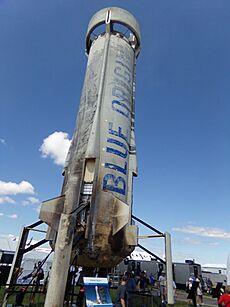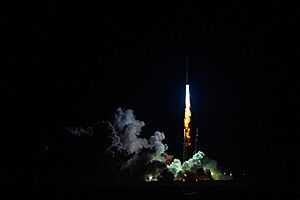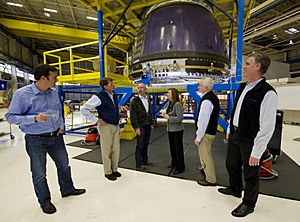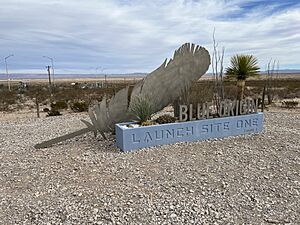Blue Origin facts for kids
| Private | |
| Industry | Space |
| Founded | September 8, 2000 |
| Founder | Jeff Bezos |
| Headquarters |
,
United States
|
|
Number of locations
|
11 (4 production facilities & 7 field offices) |
|
Area served
|
United States |
|
Key people
|
Dave Limp (CEO) |
| Products | New Shepard New Glenn Blue Moon Blue Ring Orbital Reef |
| Owner | Jeff Bezos |
|
Number of employees
|
11,000 (2023) |
| Subsidiaries | Honeybee Robotics |
|
|
|
Blue Origin Enterprises, L.P. is an American company that builds rockets and spacecraft. It is based in Kent, Washington. The company helps us explore space. They have two main rockets: the New Shepard for short trips to the edge of space, and the New Glenn for sending heavier things into orbit.
Blue Origin also makes powerful engines for its own rockets and for other companies, like the Vulcan Centaur rocket. They are also building a special spacecraft called Blue Moon to land astronauts on the Moon for NASA's Artemis program. Plus, they are developing a platform called Blue Ring and a future space station called Orbital Reef with other partners.
Jeff Bezos, who also founded Amazon, started Blue Origin in 2000. For many years, the company worked quietly. In 2015, their New Shepard rocket made history by launching and landing itself without a crew. In 2021, Jeff Bezos himself flew on the New Shepard, crossing the Kármán line, which is considered the boundary of space. In January 2023, Blue Origin delivered its first powerful BE-4 rocket engine to another company. In September 2023, Dave Limp became the new CEO of Blue Origin.
On January 16, 2025, Blue Origin successfully launched its New Glenn rocket into orbit for the first time. On April 14, 2025, the New Shepard program completed its 11th human spaceflight with an all-female crew.
Contents
- How Blue Origin Started and Grew
- Blue Origin's Amazing Rockets
- Blue Moon: Landing on the Moon
- Blue Origin's Rocket Engines
- Blue Origin's Facilities
- Other Exciting Projects
- Blue Origin Flights Before 2025
- Blue Origin's Partnerships with NASA
- Funding Blue Origin's Space Dreams
- Early Test Vehicles
- See also
How Blue Origin Started and Grew
Blue Origin was founded in 2000 by Jeff Bezos, who also started Amazon. The company worked quietly for many years. In 2006, Blue Origin bought land in Van Horn, Texas, to build its main launch site, called Launch Site One. That same year, they launched their first test rocket, named Goddard.
In 2015, Blue Origin announced plans for a much larger rocket, the New Glenn. This rocket was designed to send heavy payloads into orbit. The New Glenn successfully launched for the first time in January 2025.
A big moment for Blue Origin was on July 20, 2021. Their New Shepard rocket carried its first crewed mission, Blue Origin NS-16, to the edge of space. Jeff Bezos and his brother, along with Wally Funk and Oliver Daemen, were on board. The flight lasted about 10 minutes and crossed the Kármán line, the recognized boundary of space. Many other crewed and cargo missions followed this success.
Blue Origin also helps other space companies. In 2014, they started building the powerful BE-4 rocket engine for United Launch Alliance (ULA). This engine powers ULA's Vulcan Centaur rocket. In June 2023, the BE-4 engines were successfully tested on the Vulcan Centaur rocket.
In 2024, Blue Origin won a contract to launch important national security missions using its New Glenn rocket. On November 13, 2025, New Glenn launched its first NASA mission, called ESCAPADE, sending two science satellites to study Mars. The rocket's booster even landed safely on a special ship in the Atlantic Ocean.
Blue Origin's Amazing Rockets
Blue Origin builds two main types of rockets: New Shepard and New Glenn. Both are designed to be reusable, which means they can fly again and again, saving money and resources.
New Shepard: Your Ticket to Space
The New Shepard rocket is named after Alan Shepard, the first American in space. It is designed for short trips to the edge of space, perfect for space tourism. This rocket can take people and experiments just above the Kármán line, which is about 100 kilometers (62 miles) above Earth.
The New Shepard has two main parts: a booster rocket and a crew capsule. The capsule can carry up to six passengers or cargo. The booster uses a BE-3PM engine to launch the capsule. Once at the edge of space, passengers can experience a few minutes of weightlessness. Then, the capsule returns to Earth with parachutes, and the booster lands vertically back at the launchpad.
This rocket is fully reusable. Blue Origin has successfully launched and landed the New Shepard many times. On February 25, 2025, Blue Origin sent six passengers on its 10th space tourism mission.
New Glenn: For Big Missions to Orbit
The New Glenn is a much larger rocket, named after John Glenn, the first American to orbit Earth. It is a heavy-lift rocket, meaning it can carry very large payloads into orbit. Design work for New Glenn started in 2012.
The New Glenn rocket is 7 meters (23 feet) wide. Its first stage is powered by seven powerful BE-4 engines. This rocket also has a huge payload fairing, which is the nose cone that protects satellites during launch. It is said to be the biggest in the world.
Like New Shepard, the first stage of New Glenn is designed to be reusable. Blue Origin is even exploring ways to make the second stage reusable too. On January 16, 2025, New Glenn had its first successful launch from Cape Canaveral Space Force Station. It deployed a test satellite into orbit.
On November 13, 2025, New Glenn launched two NASA science satellites to Mars. The rocket's booster successfully landed on a special ship in the Atlantic Ocean.
Blue Moon: Landing on the Moon
In May 2019, Jeff Bezos showed plans for a lunar lander called Blue Moon. This spacecraft is designed to carry supplies and astronauts to the Moon's surface. It can transport thousands of kilograms of cargo.
Blue Origin worked with other companies to propose Blue Moon for NASA's Artemis program. In May 2023, NASA chose Blue Origin to develop the Blue Moon landing system for the Artemis V mission. This mission will help explore the Moon and prepare for future trips to Mars. The plan includes a test mission without a crew, followed by a crewed Moon landing in 2029.
The Blue Moon lander is powered by the BE-7 engine. In mid-2024, Blue Origin successfully tested the thrusters for the Blue Moon lander.
Blue Origin's Rocket Engines
Blue Origin develops its own powerful rocket engines. These engines are crucial for launching rockets and spacecraft into space.
BE-3 Engines
The BE-3 is a family of engines that use liquid hydrogen and liquid oxygen as fuel. There are two main versions:
- The BE-3U engine is used for the second stage of the New Glenn rocket.
- The BE-3PM engine powers the New Shepard rocket. It can be adjusted to control vertical landings.
These engines have been tested many times, showing they can start, stop, and restart reliably during a flight.
BE-4 Engines
The BE-4 is a very powerful engine that uses liquid oxygen and liquefied natural gas. It produces a lot of thrust.
Blue Origin partnered with United Launch Alliance (ULA) to develop the BE-4 engine. Two BE-4 engines power the first stage of ULA's Vulcan Centaur rocket. This engine replaced an older Russian-made engine. In October 2022, the first BE-4 engines were delivered to ULA. On January 8, 2024, the Vulcan Centaur rocket, powered by BE-4 engines, successfully launched for the first time.
BE-7 Engines
The BE-7 engine is being developed for the Blue Moon lunar lander. It uses liquid oxygen and liquid hydrogen. Its first tests happened in June 2019.
Pusher Escape Motor
Blue Origin also developed a special "pusher escape motor" with Aerojet Rocketdyne. This system helps the New Shepard crew capsule quickly move away from the rocket in case of an emergency during launch, keeping astronauts safe.
Blue Origin's Facilities
Blue Origin has several important locations across the United States:
- Kent, Washington: This is the company's headquarters, where much of the rocket development happens.
- Van Horn, Texas: Home to Launch Site One, where New Shepard rockets are launched and tested.
- Cape Canaveral Space Force Station, Florida: This is the Orbital Launch Site (OLS) for the New Glenn rocket.
- Huntsville, Alabama: This facility, called "Blue Engine," is where the BE-4 and BE-3U rocket engines are manufactured.
Launch Site One (LSO)
Corn Ranch, also known as Launch Site One (LSO), is Blue Origin's launch site in Van Horn, Texas. This is where the New Shepard rocket takes off and lands. The site also has test stands for different rocket engines, including the BE-3 and BE-4.
Orbital Launch Site (OLS)
The Orbital Launch Site (OLS) is located at Cape Canaveral Space Force Station in Florida. Blue Origin transformed Launch Complex 36 into a launchpad for the New Glenn rocket. This facility is used for building and testing New Glenn rockets.
Blue Origin also plans to build another New Glenn launchpad at Vandenberg Space Force Base in California. This will allow them to launch satellites into special orbits, like those that fly over the Earth's poles.
Other Exciting Projects
Blue Ring: Space Logistics
The Blue Ring spacecraft was announced in October 2023. It is designed to handle orbital logistics and deliveries in space. It has its own engine and can move things around in orbit. In March 2024, Blue Origin partnered with the United States Space Force to test Blue Ring's abilities on a mission called DarkSky-1.
Orbital Reef: A Space Business Park
Blue Origin and its partners, including Sierra Space and Boeing, are working on a commercial space station called Orbital Reef. This project received $130 million from NASA to start its design. Orbital Reef is imagined as a flexible "business park" in space. It will allow for tourism, scientific research, and manufacturing in low Earth orbit.
The station is designed to be modular, meaning new parts can be added easily. It will be able to dock with many different spacecraft, like SpaceX Dragon 2 and Boeing Starliner. In 2024, NASA increased funding for Orbital Reef, bringing the total award to $172 million.
Nuclear Rocket Program
NASA is planning to test spacecraft powered by nuclear fission by 2027. This technology could make space travel faster and more efficient. Nuclear-powered systems can be lighter than solar cells and could greatly reduce the cost and time for long space missions.
Blue Origin, along with other companies, received contracts from the Defense Advanced Research Projects Agency to develop nuclear spacecraft for the DRACO program. Blue Origin was awarded $2.9 million to design spacecraft components. They are also working with other partners on a long-range nuclear propulsion system called PADME.
Space Technology: Harvesting Lunar Resources
Blue Origin is also working on advanced space technology. In 2023, NASA awarded the company $35 million for its work on using lunar regolith (Moon dust and rock) to create solar-powered systems on the Moon.
This project, called "Blue Alchemist," aims to produce solar cells directly from lunar regolith. This breakthrough could provide unlimited electricity and power cables anywhere on the Moon's surface. It also produces oxygen, which is useful for rocket fuel and for astronauts to breathe. Blue Origin hopes to be the first company to use the Moon's natural resources.
Blue Origin Flights Before 2025
In 2025, Blue Origin achieved orbital spaceflight with the first launch of New Glenn. Below is a list of Blue Origin flights that happened before 2025. For flights after January 1, 2025, you can find them in the articles for New Glenn and New Shepard.
|
1
2
3
4
5
6
2005
2010
2015
2020
2024
|
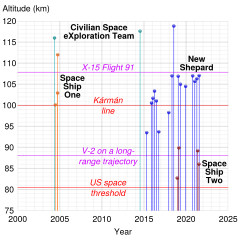
Timeline of SpaceShipOne, SpaceShipTwo, CSXT and New Shepard sub-orbital flights. Where booster and capsule achieved different altitudes, the higher is plotted. In the SVG file, hover over a point to show details.
|
In the chart below, ♺ means "Flight Proven Booster" (a booster that has flown before).
| Flight No. | Date | Vehicle | Apogee | Outcome | Notes |
|---|---|---|---|---|---|
| 1 | March 5, 2005 | Charon | 315 ft (0.05 mi) | Success | First test flight of an early vehicle. |
| 2 | November 13, 2006 | Goddard | 279 ft (0.05 mi) | Success | First rocket-powered test flight. |
| 3 | March 22, 2007 | Goddard ♺ | N/A | Success | Another test flight. |
| 4 | April 19, 2007 | Goddard ♺ | N/A | Success | Continued testing. |
| 5 | May 6, 2011 | PM2 (Propulsion Module) | N/A | Success | Test flight of another early vehicle. |
| 6 | August 24, 2011 | PM2 (Propulsion Module) ♺ | N/A | Failure | Vehicle lost during flight test. |
| 7 | October 19, 2012 | New Shepard capsule | N/A | Success | Test of the capsule's emergency escape system. |
| 8 | April 29, 2015 | New Shepard 1 | 307,000 ft (58 mi) | Partial success | Capsule recovered, but booster crashed during landing. |
| 9 | November 23, 2015 | New Shepard 2 | 329,839 ft (62 mi) | Success | First successful sub-orbital flight and vertical landing of the booster. |
| 10 | January 22, 2016 | New Shepard 2 ♺ | 333,582 ft (63 mi) | Success | Successful flight and landing of a reused booster. |
| 11 | April 2, 2016 | New Shepard 2 ♺ | 339,178 ft (64 mi) | Success | Another successful flight and landing of the same booster. |
| 12 | June 19, 2016 | New Shepard 2 ♺ | 331,501 ft (63 mi) | Success | Fourth successful launch and landing of the same rocket. |
| 13 | October 5, 2016 | New Shepard 2 ♺ | Booster: 307,458 ft (58 mi) Capsule: 23,269 ft (4 mi) |
Success | Fifth and final flight of this booster. Tested the in-flight abort system. |
| 14 | December 12, 2017 | New Shepard 3 | Booster: 322,032 ft (61 mi) Capsule: 322,405 ft (61 mi) |
Success | First launch of the New Shepard 3 booster and a new Crew Capsule 2.0. |
| 15 | April 29, 2018 | New Shepard 3 ♺ | 351,000 ft (66 mi) | Success | Successful flight and landing of the reused booster. |
| 16 | July 18, 2018 | New Shepard 3 ♺ | 389,846 ft (74 mi) | Success | Carried a test dummy. Tested the in-flight abort system at high altitude. |
| 17 | January 23, 2019 | New Shepard 3 ♺ | 351,000 ft (66 mi) | Success | Carried eight NASA research payloads. |
| 18 | May 2, 2019 | New Shepard 3 ♺ | 346,000 ft (65 mi) | Success | Carried 38 microgravity research payloads. |
| 19 | December 11, 2019 | New Shepard 3 ♺ | 343,000 ft (64 mi) | Success | Carried research and educational payloads, including postcards from students. |
| 20 | October 13, 2020 | New Shepard 3 ♺ | 346,000 ft (65 mi) | Success | Seventh flight of the same capsule/booster. Carried 12 payloads, including NASA lunar landing tech. |
| 21 | January 14, 2021 | New Shepard 4 | 350,858 ft (66 mi) | Success | Uncrewed test flight for the new NS4 rocket and "RSS First Step" capsule. |
| 22 | April 14, 2021 | New Shepard 4 ♺ | 348,753 ft (66 mi) | Success | NS-15. Astronaut rehearsal with Blue Origin staff. |
| 23 | July 20, 2021 | New Shepard 4 ♺ | 351,210 ft (66 mi) | Success | NS-16. First crewed flight with Jeff Bezos and others. |
| 24 | August 26, 2021 | New Shepard 3 ♺ | 347,434 ft (66 mi) | Success | NS-17. Carried 18 commercial payloads and NASA tech. |
| 25 | October 13, 2021 | New Shepard 4 ♺ | 341,434 ft (66 mi) | Success | NS-18. Second crewed flight, including William Shatner. |
| 26 | December 11, 2021 | New Shepard 4 ♺ | 351,050 ft (66 mi) | Success | NS-19. Third crewed flight. |
| 27 | March 31, 2022 | New Shepard 4 ♺ | 351,050 ft (66 mi) | Success | NS-20. Fourth crewed flight. |
| 28 | June 4, 2022 | New Shepard 4 ♺ | 351,050 ft (66 mi) | Success | NS-21. Fifth crewed flight. |
| 29 | August 4, 2022 | New Shepard 4 ♺ | 351,050 ft (66 mi) | Success | NS-22. Sixth crewed flight. |
| 30 | September 12, 2022 | New Shepard 3 ♺ | 37,402 ft (7 mi) | Failure | NS-23. Uncrewed flight. Booster failed, but capsule landed safely using its escape system. |
| 31 | December 19, 2023 | New Shepard 4 ♺ | 351,248 ft (107.060 km; 66.5242 mi) | Success | NS-24. Successful return to flight after the NS-23 failure. Carried 33 payloads and postcards. |
| 32 | 19 May 2024 | New Shepard 4 ♺ | c. 106 km | Success | NS-25. Seventh crewed New Shepard flight. |
| 33 | 29 August 2024 | New Shepard 4 ♺ | Capsule 105.3 km (65.4 mi) | Success | NS-26. Eighth crewed New Shepard flight. |
| 34 | 23 October 2024 | New Shepard 5 | Capsule 101 km (63 mi) | Success | NS-27. First flight of the new NS5 booster and capsule. |
| 35 | 22 November 2024 | New Shepard 4 ♺ | Capsule 105.3 km (65.4 mi) | Success | NS-28. Ninth crewed New Shepard flight. |
Blue Origin's Partnerships with NASA
Blue Origin works closely with NASA on many projects. In 2009, NASA provided funding to Blue Origin to develop technologies for future human spaceflight. This included an innovative "pusher" escape system for crew safety.
In 2011, NASA gave Blue Origin more funding to continue developing its orbital space vehicle and the BE-3 engine. Blue Origin also tried to lease a launchpad at Kennedy Space Center from NASA, but the contract was awarded to SpaceX.
In 2020, Blue Origin and its partners won a $579 million contract from NASA. This was to start developing a Human Landing System (HLS) for the Artemis program to return humans to the Moon. However, NASA later chose SpaceX for the main HLS contract for Artemis missions II, III, and IV.
Despite this, Blue Origin continued to receive funding from NASA for lunar lander projects and sub-orbital research flights. In December 2022, Blue Origin submitted a second proposal for a lunar lander. On May 19, 2023, NASA contracted Blue Origin to develop the Blue Moon landing system for the Artemis V mission. This $3.4 billion contract includes a test mission and a crewed Moon landing planned for 2029.
On August 12, 2025, Blue Origin proposed a Mars Telecommunications Orbiter mission. This orbiter would help with Mars Sample Return missions and future crewed missions to Mars. It would use Blue Origin's Blue Ring Satellite Platform.
Funding Blue Origin's Space Dreams
Jeff Bezos has invested a lot of his own money into Blue Origin. By July 2014, he had put over $500 million into the company. In 2017, it was reported that he sold about $1 billion in Amazon stock each year to invest in Blue Origin.
The company also receives funding from the U.S. government. In 2019, the United States Air Force gave Blue Origin $181 million for rocket development. In November 2022, an agreement was made for the New Glenn rocket to compete for national security launch contracts. This means New Glenn can launch important government satellites once it completes its certifications.
In 2023, Blue Origin's CEO, Bob Smith, mentioned that the company had hundreds of millions in revenue and billions of dollars in orders. Blue Origin is also part of the DARPA lunar programs, studying how to operate on the Moon's surface.
Early Test Vehicles
Blue Origin started its journey with several test vehicles to learn how to build rockets and control them.
Charon: The First Test Flight

The company's very first test vehicle was named Charon, after one of Pluto's moons. Instead of rockets, it used four jet engines. Charon was built to test how to guide and control a vehicle autonomously. It made its only test flight on March 5, 2005, flying to an altitude of 316 feet before landing safely. Today, Charon is on display at the Museum of Flight in Seattle, Washington.
Goddard: The First Rocket Test
The next test vehicle was named Goddard. It first flew on November 13, 2006, and was a success. The Goddard vehicle used Blue Engine-1 (BE-1), Blue Origin's first rocket engine, which used peroxide fuel.
PM2: More Early Tests
Another early test vehicle, PM2 (likely short for "Propulsion Module"), had two test flights in 2011. The first flight was a short hop. The second flight, on August 24, 2011, unfortunately failed when the company lost control of the vehicle. It was lost after reaching a speed of Mach 1.2 and an altitude of 14 kilometers (9 miles). PM2 was powered by five BE-2 engines, which used kerosene and peroxide fuel.
See also
 In Spanish: Blue Origin para niños
In Spanish: Blue Origin para niños


